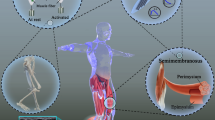Abstract
Recent achievements in tissue-engineering research make it viable to construct biological tissue and organs in vitro from living cells and a scaffold substrate. This technology can be applied not only to patients for regenerating malfunctioning tissue and organs in vivo but also to other purposes such as three-dimensional tissue modeling for drug screening in vitro. The aim of this chapter is to describe bioactuators, which are actuators made of cultured skeletal muscle cells in vitro, on the basis of our investigations. Living muscles are driven by actin–myosin molecular motors through transformation of the biochemical energy of adenosine triphosphate (ATP) into mechanical energy. They have excellent characteristics of light weight, high flexibility, and remarkable efficiency for energy conversion in comparison with mechanical actuators that require electricity as a power source. Therefore, bioactuators have the potential to be flexible and highly efficient actuators on a micro- to macroscale. Tissue-engineered skeletal muscle with a native-like contractile property has been successfully constructed and adapted as a bioactuator to drive a microlever object. There are still several issues to be resolved for creation of a large and powerful bioactuator that works long term with proven reliability, and these are expected to be addressed in the near future through intensive and vigorous tissue-engineering studies.
Access this chapter
Tax calculation will be finalised at checkout
Purchases are for personal use only
Similar content being viewed by others
References
Langer R, Vacanti JP (1993) Tissue engineering. Science 260(5110):920–926
Reddi AH (1998) Role of morphogenetic proteins in skeletal tissue engineering and regeneration. Nat Biotechnol 16:247–252
Takebe T, Sekine K, Kimura M et al (2017) Massive and reproducible production of liver buds entirely from human pluripotent stem cells. Cell Rep 21(10):2661–2670
Yamanaka S, Tajiri S, Fujimoto T et al (2017) Generation of interspecies limited chimeric nephrons using a conditional nephron progenitor cell replacement system. Nat Commun 8(1):1719
Mandai M, Watanabe A, Kurimoto Y et al (2017) Autologous induced stem-cell-derived retinal cells for macular degeneration. N Engl J Med 376(11):1038–1046
Burke RE, Levine DN, Tsairis P, Zajac FE 3rd (1973) Physiological types and histochemical profiles in motor units of the cat gastrocnemius. J Physiol 234(3):723–748
Hill AB, Chiu RC (1989) Dynamic cardiomyoplasty for treatment of heart failure. Clin Cardiol 12(12):681–688
Miyagawa S, Domae K, Yoshikawa Y et al (2017) Phase I clinical trial of autologous stem cell-sheet transplantation therapy for treating cardiomyopathy. J Am Heart Assoc 6(4):e003918
Dennis RG, Kosnik PE 2nd, Gilbert ME, Faulkner JA (2001) Excitability and contractility of skeletal muscle engineered from primary cultures and cell lines. Am J Physiol Cell Physiol 280(2):C288–C295
Huang YC, Dennis RG, Larkin L, Baar K (2005) Rapid formation of functional muscle in vitro using fibrin gels. J Appl Physiol 98(2):706–713
Nakamura T, Takagi S, Kamon T, Yamasaki KI, Fujisato T (2017) Development and evaluation of a removable tissue-engineered muscle with artificial tendons. J Biosci Bioeng 123(2):265–271
Takagi S, Nakamura T, Fujisato T (2018) Effect of heat stress on contractility of tissue-engineered artificial skeletal muscle. J Artif Organs 21(2):207–214
Shimizu K, Fujita H, Nagamori E (2013) Evaluation systems of generated forces of skeletal muscle cell-based bio-actuators. J Biosci Bioeng 115(2):115–121
Powell CA, Smiley BL, Mills J, Vandenburgh HH (2002) Mechanical stimulation improves tissue-engineered human skeletal muscle. Am J Physiol Cell Physiol 283(5):C1557–C1565
Acknowledgements
This work was partly supported by Japan Society for the Promotion of Science (JSPS) Grants-in-Aid for Scientific Research (KAKENHI) grant numbers 24500521 and 16K01383.
Author information
Authors and Affiliations
Corresponding author
Editor information
Editors and Affiliations
Rights and permissions
Copyright information
© 2019 Springer Nature Singapore Pte Ltd.
About this chapter
Cite this chapter
Fujisato, T., Takagi, S., Nakamura, T., Tsutsui, H. (2019). Tissue-Engineering Approach to Making Soft Actuators. In: Asaka, K., Okuzaki, H. (eds) Soft Actuators. Springer, Singapore. https://doi.org/10.1007/978-981-13-6850-9_38
Download citation
DOI: https://doi.org/10.1007/978-981-13-6850-9_38
Published:
Publisher Name: Springer, Singapore
Print ISBN: 978-981-13-6849-3
Online ISBN: 978-981-13-6850-9
eBook Packages: Chemistry and Materials ScienceChemistry and Material Science (R0)




